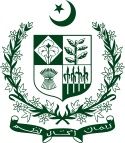| |||||||||||||||||||||||||||||||||||||
All 342 seats in the National Assembly 172 seats needed for a majority | |||||||||||||||||||||||||||||||||||||
|---|---|---|---|---|---|---|---|---|---|---|---|---|---|---|---|---|---|---|---|---|---|---|---|---|---|---|---|---|---|---|---|---|---|---|---|---|---|
| Turnout | 44.34% ( | ||||||||||||||||||||||||||||||||||||
| |||||||||||||||||||||||||||||||||||||
 Results by constituency | |||||||||||||||||||||||||||||||||||||
| |||||||||||||||||||||||||||||||||||||
 |
|---|
|
|
General elections were held in Pakistan on 18 February 2008 to elect members of the 13th National Assembly and the four Provincial Assemblies.[1][2]
On 3 November 2007 President Pervez Musharraf enacted a state of emergency; elections were initially postponed indefinitely.[3] However, it was later stated they would be held as planned.[4] On 8 November 2007 Musharraf announced that the elections would be held by 15 February 2008,[5] before suggesting a date of 8 January.[6] Following the assassination of former Prime Minister Benazir Bhutto in December 2007, the Election Commission conducted a meeting and announced that 8 January was no longer a feasible date and the elections would be held on 18 February.[7]
The elections saw the resurgence of the Pakistan Peoples Party (PPP) and Pakistan Muslim League (N) (PML-N), as they emerged as the two largest parties in the National Assembly. Following Bhutto's death, the PPP had come under the leadership of her nineteen-year-old son Bilawal. However, the party's election campaign was led by Benazir's husband and Bilawal's father Asif Ali Zardari, in his capacity as the co-chairman of the party. Meanwhile, PML-N was under the leadership of Chaudhry Nisar Ali Khan, although the party's eponymous founder Nawaz Sharif had returned from exile and was taking part in the Election campaign. At the provincial level, the PPP won in Sindh, the PML-N dominated in Punjab, the Awami National Party emerged as the largest party in North-West Frontier Province and Musharraf's Pakistan Muslim League (Q) won the most seats in Balochistan. Around 35.2 million people voted, with voter turnout just 44%.[8]
Musharraf conceded the defeat of his party and pledged to work with the new Parliament.[9] Due to a common mistrust of Musharraf, the PPP and PML-N initially formed a coalition government. Although Ameen Faheem was expected to lead the new government, PPP leaders agreed to appoint Yousaf Raza Gillani as Prime Minister. Within a week, the PML-N left the coalition to lead the impeachment movement and a campaign to restore the judiciary. The PPP instead formed a government with the Muttahida Qaumi Movement, Awami National Party and Jamiat Ulema-e-Islam (F).
By-elections for 28 seats (23 provincial and five national) were delayed numerous times, with most of them held as late as 26 June 2008.
- ^ Ahmed Rashid (10 January 2007). "Pakistan's uncertain year ahead". BBC News. Retrieved 9 July 2007.
- ^ "Election Tracker: Pakistan". Angus Reid Global Monitor. Archived from the original on 28 August 2007. Retrieved 9 July 2007.
- ^ "Musharraf targets key opponents". BBC News. 4 November 2007. Retrieved 20 February 2008.
- ^ "Pakistan 'to keep elections date'". BBC News. 5 November 2007. Retrieved 20 February 2008.
- ^ "Musharraf vows polls in February". BBC News. 8 November 2007. Retrieved 20 February 2008.
- ^ "Musharraf recommends general elections to be held on Jan. 8 – People's Daily Online". 2008. Retrieved 20 February 2008.
- ^ "Pakistan Delays Vote After Bloodshed". Sky News. 1 February 2008. Archived from the original on 6 September 2008. Retrieved 1 February 2008.
- ^ "Panorama of Parliamentary Elections 2008" An Annual Publicationof the Inter-Parliamentary Union, 2008 ed.
- ^ Perlez, Jane; Gall, Carlotta (20 February 2008). "In Pakistan, Musharraf's Party Accepts Defeat". The New York Times. Retrieved 20 February 2008.[permanent dead link]




